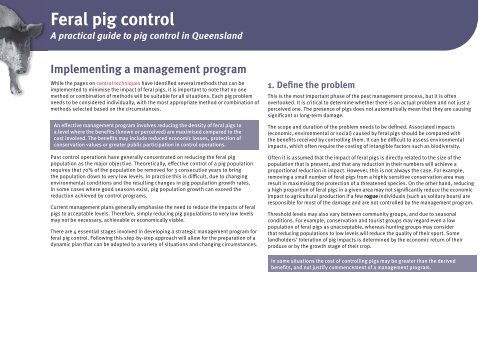Ipa Feral Pig Control Manual - Department of Primary Industries ...
Ipa Feral Pig Control Manual - Department of Primary Industries ...
Ipa Feral Pig Control Manual - Department of Primary Industries ...
You also want an ePaper? Increase the reach of your titles
YUMPU automatically turns print PDFs into web optimized ePapers that Google loves.
<strong>Feral</strong> pig control<br />
A practical guide to pig control in Queensland<br />
Implementing a management program<br />
While the pages on control techniques have identified several methods that can be<br />
implemented to minimise the impact <strong>of</strong> feral pigs, it is important to note that no one<br />
method or combination <strong>of</strong> methods will be suitable for all situations. Each pig problem<br />
needs to be considered individually, with the most appropriate method or combination <strong>of</strong><br />
methods selected based on the circumstances.<br />
An effective management program involves reducing the density <strong>of</strong> feral pigs to<br />
a level where the benefits (known or perceived) are maximised compared to the<br />
cost involved. The benefits may include reduced economic losses, protection <strong>of</strong><br />
conservation values or greater public participation in control operations.<br />
Past control operations have generally concentrated on reducing the feral pig<br />
population as the major objective. Theoretically, effective control <strong>of</strong> a pig population<br />
requires that 70% <strong>of</strong> the population be removed for 3 consecutive years to bring<br />
the population down to very low levels. In practice this is difficult, due to changing<br />
environmental conditions and the resulting changes in pig population growth rates.<br />
In some cases where good seasons exist, pig population growth can exceed the<br />
reduction achieved by control programs.<br />
Current management plans generally emphasise the need to reduce the impacts <strong>of</strong> feral<br />
pigs to acceptable levels. Therefore, simply reducing pig populations to very low levels<br />
may not be necessary, achievable or economically viable.<br />
There are 4 essential stages involved in developing a strategic management program for<br />
feral pig control. Following this step-by-step approach will allow for the preparation <strong>of</strong> a<br />
dynamic plan that can be adapted to a variety <strong>of</strong> situations and changing circumstances.<br />
1. Define the problem<br />
This is the most important phase <strong>of</strong> the pest management process, but it is <strong>of</strong>ten<br />
overlooked. It is critical to determine whether there is an actual problem and not just a<br />
perceived one. The presence <strong>of</strong> pigs does not automatically mean that they are causing<br />
significant or long-term damage.<br />
The scope and duration <strong>of</strong> the problem needs to be defined. Associated impacts<br />
(economic, environmental or social) caused by feral pigs should be compared with<br />
the benefits received by controlling them. It can be difficult to assess environmental<br />
impacts, which <strong>of</strong>ten require the costing <strong>of</strong> intangible factors such as biodiversity.<br />
Often it is assumed that the impact <strong>of</strong> feral pigs is directly related to the size <strong>of</strong> the<br />
population that is present, and that any reduction in their numbers will achieve a<br />
proportional reduction in impact. However, this is not always the case. For example,<br />
removing a small number <strong>of</strong> feral pigs from a highly sensitive conservation area may<br />
result in maximising the protection <strong>of</strong> a threatened species. On the other hand, reducing<br />
a high proportion <strong>of</strong> feral pigs in a given area may not significantly reduce the economic<br />
impact to agricultural production if a few rogue individuals (such as solitary boars) are<br />
responsible for most <strong>of</strong> the damage and are not controlled by the management program.<br />
Threshold levels may also vary between community groups, and due to seasonal<br />
conditions. For example, conservation and tourist groups may regard even a low<br />
population <strong>of</strong> feral pigs as unacceptable, whereas hunting groups may consider<br />
that reducing populations to low levels will reduce the quality <strong>of</strong> their sport. Some<br />
landholders’ toleration <strong>of</strong> pig impacts is determined by the economic return <strong>of</strong> their<br />
produce or by the growth stage <strong>of</strong> their crop.<br />
In some situations the cost <strong>of</strong> controlling pigs may be greater than the derived<br />
benefits, and not justify commencement <strong>of</strong> a management program.
















